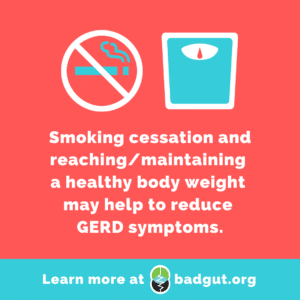Click here to download a PDF of this information.
Gastroesophageal reflux disease (GERD)
Gastroesophageal reflux disease occurs when the upper portion of the digestive tract is not functioning properly, causing stomach contents to flow back into the esophagus. The esophagus is a muscular tube linking the mouth to the stomach. In normal digestion, a specialized ring of muscle at the bottom of the esophagus called the lower esophageal sphincter (LES) opens to allow food to pass into the stomach and then quickly closes to prevent backflow into the esophagus. The LES can malfunction, allowing contents from the stomach, including food and digestive juices, such as hydrochloric acid, to push up into the esophagus. In gastroesophageal reflux disease (GERD), this backflow is ongoing.
Symptoms of GERD
 Acid reflux is responsible for the majority of the symptoms and/or damage to the esophagus. Approximately 13-29% of Canadians experience recurring GERD symptoms. GERD has a significant negative impact on wellbeing and quality of life.
Acid reflux is responsible for the majority of the symptoms and/or damage to the esophagus. Approximately 13-29% of Canadians experience recurring GERD symptoms. GERD has a significant negative impact on wellbeing and quality of life.
Heartburn is the most common symptom of GERD. It usually feels like a burning pain in the chest, beginning behind the breastbone and moving toward the neck and throat. It often worsens after eating and while lying down, and can last for a few hours at a time. Pain results from the irritating effects of stomach acid on the inner esophagus wall, which does not have the same natural protection from acid that exists in the stomach lining.
Another common symptom is a sensation of food or liquid coming up into the throat or mouth (regurgitation), especially when bending over or lying down. This can leave a bitter or sour taste in the mouth. While many Canadians experience occasional heartburn or regurgitation, these symptoms are frequent in persons with GERD who are not receiving adequate treatment.
Individuals with GERD can also experience less common symptoms, including persistent sore throat, hoarseness, chronic coughing, difficult or painful swallowing, asthma, unexplained chest pain, bad breath, a feeling of a lump in the throat, and an uncomfortable feeling of fullness after meals.
Acid erosion of tooth enamel, which a dentist will notice, can be a sign of GERD in someone who is not yet experiencing typical symptoms.
In some cases, the acid may travel all the way up the esophagus past the upper esophageal sphincter (UES) and damage the structures in the throat. Known as laryngopharyngeal reflux disease (LPR), this has now become an important diagnosis for physicians to consider in individuals with chronic throat clearing, coughing, and a feeling of a lump in the throat. Sometimes, the acid lingering in the throat is drawn into the lungs, irritating the delicate tissues there and causing symptoms that mimic those common in lung diseases. A person could have LPR without symptoms of heartburn because the larynx is much more sensitive to acid injury than is the esophagus.
Too much stomach acid reflux can result in inflammation of the esophagus (esophagitis), which can lead to esophageal bleeding or ulcers. Chronic scarring may narrow the esophagus and interfere with a person’s ability to swallow, requiring surgery. Rarely, some individuals may develop a condition known as Barrett’s Esophagus that is severe damage to the cells lining the lower area of the esophagus, which increases the risk of developing esophageal cancer. Please talk to your physician if your GERD symptoms change.
Diagnosing GERD
In most cases, if your symptoms are primarily heartburn or acid regurgitation, your doctor can accurately diagnose GERD. However, testing may be required to confirm the diagnosis or to determine the degree of esophageal damage from GERD. Testing also rules out other possible causes of your symptoms. These tests may include an upper GI series, an upper GI endoscopy, and 24-hour pH monitoring. Other less frequently performed tests include the Bernstein test and esophageal manometry.
Management of GERD
Dietary and Lifestyle Modifications
 Although clinical evidence suggests that dietary and lifestyle modifications are usually not sufficient to bring chronic GERD under control, your physician might suggest a number of dietary and lifestyle changes directed at reducing your symptoms, and adhering to these recommendations might provide some relief. The first goal of treatment is to prevent the reflux of stomach acid into the esophagus. Foods that trigger reflux and its symptoms vary from person to person. By paying close attention to your diet and symptoms, you may be able to identify which foods repeatedly contribute to your reflux. Common trigger foods include alcohol, caffeine, fatty foods, and some spices. Avoiding large portions at mealtime and eating smaller, more frequent meals might aid in symptom control.
Although clinical evidence suggests that dietary and lifestyle modifications are usually not sufficient to bring chronic GERD under control, your physician might suggest a number of dietary and lifestyle changes directed at reducing your symptoms, and adhering to these recommendations might provide some relief. The first goal of treatment is to prevent the reflux of stomach acid into the esophagus. Foods that trigger reflux and its symptoms vary from person to person. By paying close attention to your diet and symptoms, you may be able to identify which foods repeatedly contribute to your reflux. Common trigger foods include alcohol, caffeine, fatty foods, and some spices. Avoiding large portions at mealtime and eating smaller, more frequent meals might aid in symptom control.
Many overweight individuals find symptom relief when they lose some weight, as excess bulk, especially around the abdomen, might put pressure on the digestive tract, negatively affecting its function. Avoid clothes that fit tightly around the waist, as these also increase abdominal stress.
Smoking cessation is also important for reducing GERD symptoms, as studies point to relaxation of the LES with smoking.
People who have GERD should avoid lying down right after eating and refrain from eating within two to three hours of bedtime.
To reduce nighttime symptoms, elevating the head of the bed about six inches may also help, but make sure to do this by propping up the mattress or bed frame, not by using pillows. Using pillows can lead to back or neck pain and compression on the stomach that could actually increase GERD symptoms.
Medications
There are two main approaches to treating GERD with medications: neutralizing acid and blocking its production.
For neutralizing acid, over-the-counter medications such as Maalox®, Tums®, and Pepto-Bismol® may subdue symptoms. Another product, Gaviscon®, neutralizes stomach acid and forms a barrier to block acid rising into the esophagus. Some find that these non-prescription antacids provide quick, temporary, or partial relief but they do not prevent heartburn. Consult your physician if you are using antacids for more than three weeks.
Two classes of medication that suppress acid secretion are histamine-2 receptor antagonists (H2RAs) and proton pump inhibitors (PPIs).
- H2RAs work by blocking the effect of histamine, which stimulates certain cells in the stomach to produce acid. These include cimetidine (Tagamet®), ranitidine (Zantac®), famotidine (Pepcid®), and nizatidine (Axid®). H2RAs are all available by prescription and some are accessible in a lower dose non-prescription formulation.
- PPIs work by blocking an enzyme necessary for acid secretion. They have the best effect when taken on an empty stomach, a half-hour to one hour before the first meal of the day. PPIs include omeprazole (Losec®), lansoprazole (Prevacid®), pantoprazole sodium (Pantoloc®), esomeprazole (Nexium®), rabeprazole (Pariet®), and pantoprazole magnesium (Tecta®). Dual delayed release PPI capsules, in the form of dexlansoprazole (Dexilant®), deliver the medication at two intervals. PPIs have emerged as the most effective therapy for relieving symptoms and improving quality of life, as well as healing and preventing damage to the esophagus, in individuals with GERD. In Canada, PPIs are available only by prescription. Longer-term and multiple daily dose PPI therapy may be associated with an increased risk for osteoporosis-related fractures of the hip, wrist, or spine.
Treatments that reduce reflux by increasing LES pressure and downward esophageal contractions are metoclopramide and domperidone maleate. A plant-based prokinetic agent, Iberogast®, helps regulate digestive motility and improve GERD symptoms.
All of the medications discussed above have specific treatment regimens, which you must follow closely for maximum effect. Usually, a combination of these measures can successfully control the symptoms of acid reflux.
Some other medications and/or supplements may aggravate GERD. Be sure to ask your pharmacist or physician if any products you are currently taking could be affecting your symptoms.
GERD Outlook
GERD is a chronic condition that can range from mild to severe. Individuals can successfully manage most cases of GERD with lifestyle and dietary changes and medications. Serious complications are rare.
Want to learn more about GERD?
We have several related articles that may be helpful:
- H. pylori and Halitosis (Bad Breath)
- Achalasia
- Baking Soda for Heartburn
- Beans We Drink
- Children with Reflux (GERD)
- Could a GI Condition Be Causing Your Chronic Cough?
- Do PPIs inhibit the gut microbiome?
- Dysphagia
- Functional Dyspepsia
- Fundoplication
- Gastroesophageal reflux disease (GERD)
- Gastroesophageal Reflux Disease (GERD) Video
- Gastrointestinal Issues Associated with Obesity
- Gender and the Gut
- GERD and Dental Erosion
- GERD and Heartburn Tips
- GERD on the Rise
- GERD PSA
- Glycemic Index and Diet
- Heartburn Keeping You Up at Night?
- Hiatus Hernia
- Hiccups
- How Cystic Fibrosis and Fabry Disease Affect the Gut
- How to Avoid GERD Symptoms While Working Out
- Managing GERD with PPIs
- Natural and Over-the-Counter Heartburn Treatments
- Nutrition and Lifestyle Tips for GERD
- Nutrition and the Aging Gut Video
- Photodynamic Therapy for Barrett’s Esophagus
- Physical Activity and GI Health
- PPI Therapy and Bone Fractures
- Progressive Diseases of the Esophagus
- Tecta®
- The Cost of Therapeutic Substitution
- The Unassuming Wonders of the Esophagus
- Therapeutic Substitution
- Treating Sleep Apnea May Ease GERD
- Waking to GERD















